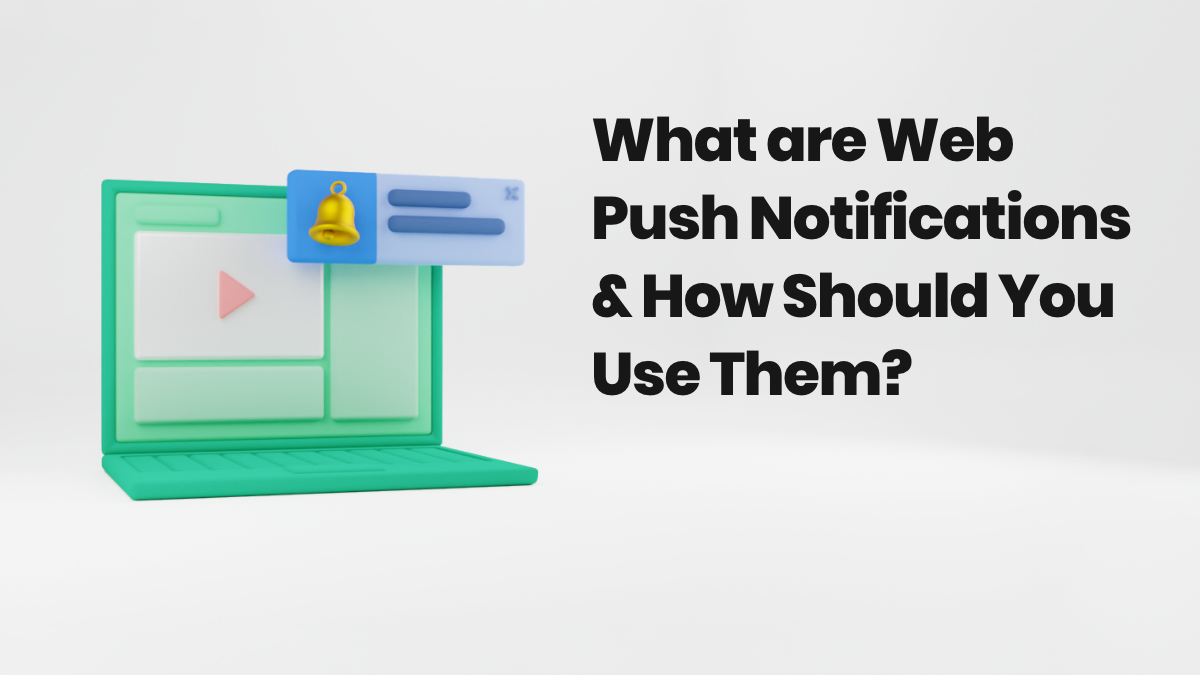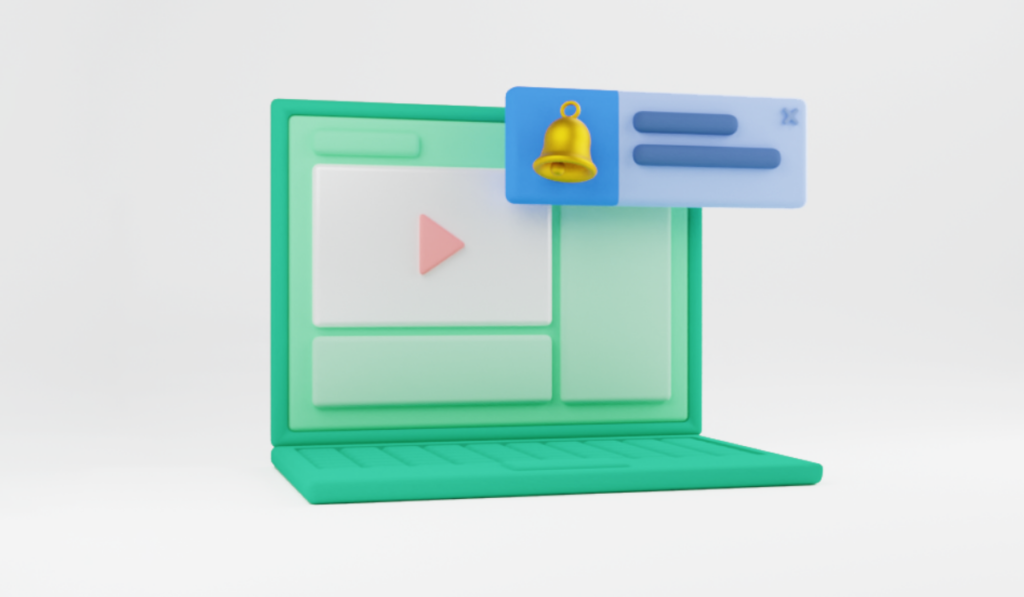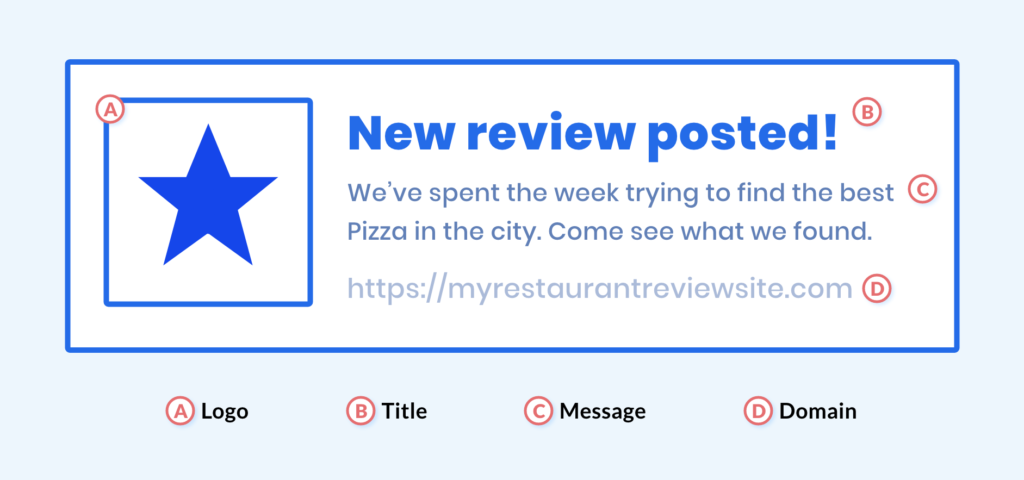What Are Web Push Notifications & How Should You Use Them?

What do successful marketing strategies and breakfast have in common?
Answer: The best ones involve variety.
Think about it. A healthy breakfast means eating a variety of foods — fruit, toast, eggs. You need a variety of foods with different nutrients to fuel your body and stay healthy.
A healthy marketing plan needs variety, too. To be successful with marketing, you need to use different tactics and test strategies to find what works for your business. You can’t go all in on one thing, and one thing only.
Side note: if you hear “this is the only tool you need,” turn and run the other way. Always be skeptical of tools or strategies that promise it all. Small business influencer Rieva Lesonsky talks about this more on The FWD: Thinking Show.
So what can you do to diversify your marketing strategy?
Enter: web push notifications. Not only do push notifications let you communicate updates to your audience, they enable you to drive traffic to your website or landing page, build your audience, and grow your business. Plus, they work great in tandem with email marketing.
Read on to learn all about web push notifications and how you can use them to complement your marketing strategy.
What are web push notifications?
Web push notifications — also known as desktop notifications or simply push notifications — are short, one-time messages that are delivered straight to a subscriber’s desktop when they have a browser open.
Web push notifications are sent to people who have opted-in to receive messages from you. Once they’ve opted-in, subscribers do not have to be on your website in order to receive a push notification.
They usually appear in a corner of your desktop or laptop screen and serve to alert your audience of exclusive deals, offers, promotions, or even freebies.
The goal of push notifications is to drive your audience back to your website or landing page and take the action you want them to take.

What’s the difference between a web push notification, an in-browser notification, and a mobile push notification?
An in-browser notification is another form of online messaging that targets active website visitors when they are actively on your website.
Mobile push notifications are the types of notifications that appear on a mobile device. These messages go to a user’s phone and show up on a lock screen. When a user opens a push notification, it will bring the user to whatever app sent the message. Much like web push notifications, users can opt-in and opt-out of receiving notifications.
But in this guide, we’ll be covering all you need to know about web push notifications. They differ from in-browser notifications and mobile push notifications in that a user does not need to be on the website in order to receive the push notification. This allows marketers to reach users when they’re not actively engaging on a website.
Why marketers should use web push notifications
Marketers use web push notifications to build, inform, and retain their audience. Web push notifications capture subscribers’ attention, no matter what they’re doing online.
Whether a person is in their email inbox, scrolling social media, or browsing their favorite ecommerce sites, if they are subscribed to your opt-in messages, they will receive them.
And the stats speak for themselves. Sendx estimates web push notifications could yield up to a 10% opt-in rate since no personal information is required upon opt-in. Plus, the click through rate on web push notifications could be 4x-8x that of email.
Web push notifications also offer marketers a more flexible form of communication, allowing subscribers to opt-in and opt-out with more freedom than a typical full page popup modal.
There are three primary reasons why marketers use web push notifications to elevate their marketing strategy.
- To inform. Web push notifications are a great way to keep subscribers in the loop with exclusive content, offers, deals and more. Ultimately, subscribers can’t take action if they’re not aware of special deals or new content that you want to send out on push notifications.
- To engage. Web push notifications provide a unique opportunity for users to engage with your brand, even when they’re not actively on your website.
- To sell. Capitalize on subscribers being on their desktop to let them know about an exclusive offer. You never know what they might be looking for online and if you can provide it for them, a push notification is a simple, straightforward way to communicate your value.
What do push notifications look like?
While simple in design and layout, these push notifications pack a powerful punch in a little package.

As you can see from the image above, there are 4 components of a web push notification — let’s break them down.
- Logo. Including a brand logo on a web push notification provides instant recognition from a user. It’s a highly visual way for a subscriber to recognize that the message is coming from your brand, and can drive them to read the notification and take action.
- Title. The title of the web push notification is also called the header text. This is the piece of text that will catch the attention of a subscriber and decide to read on.
- Message. This vital section is where you can elaborate your message. This is your opportunity to concisely explain the value a subscriber receives from clicking on your push notification and visiting your site. Answer questions like: what will your subscribers receive by visiting your site? How long will the offer last? Keep in mind, however, that web push notifications are meant to be short and sweet.
- Domain. This is the URL that the user subscribed to. Including the source link in your message can’t be changed. It not only serves to remind the subscriber of your website, but aids in recognition and awareness of your online presence.
How to use push notifications in your marketing strategy
Now that you know the basics about web push notifications and the benefit of using them, let’s get into how to use push notifications as a part of your broader marketing strategy.
Getting started with push notifications as a marketing tactic
When considering web push notifications as part of your broader marketing strategy, there’s a few things you want to consider:
- Align your strategy with your business goals.
Is your goal to get more website traffic? Do you want to make more sales? Drive visitors to view new content or sign up for a guide?
Whatever your business goals are, consider how web push notifications can support them. This will help you figure out what kind of messages you want to send out to your audience.
- Think about the user experience.
When a website visitor signs up to receive your push notifications, what will they experience? Where do you want to take them? What actions do you want them to take? How will you control the message and make sure they’re receiving value?
- Use push notifications in tandem with other marketing tactics.
Make sure that push notifications fit in with how you’re marketing your business across all your marketing channels. You may have heard this described as cross-channel marketing, or omnichannel marketing.
This means that people experience the brand consistently across different marketing channels, which is why maintaining a consistent brand voice and branding is key.
But why is this so important? According to Omnisend, marketers using three or more channels in any one campaign earned a 287% higher purchase rate than those using a single-channel campaign.
Let’s get into this deeper and look at how you can use push notifications along with email marketing in your strategy.
How to use web push notifications and email marketing together
Web push notifications and email marketing support each other in many ways.
While your email subscribers and your web push notification subscribers are independent of one another — meaning those who sign up for your email list don’t automatically become web push notification subscribers, and vice versa — you can drive subscribers of one to become subscribers of the other.
Let’s break down how to grow your web push notification subscribers using your email list.
Step 1: Write the Opt-In Prompt
In order to start collecting web push notification subscribers, you need to ask your website visitors if they’d like to subscribe to receive notifications from you.
That initial ask is called the opt-in prompt. The goal of the opt-in prompt is to encourage website visitors to allow you to send them push notifications to their desktop.
Writing a compelling opt-in prompt begins by explaining what a subscriber will receive from you. This offer has to be valuable to the reader in order for them to let you send them notifications.
Step 2: Ask your email list to subscribe to your web push notifications
Alert email subscribers about opting in to receive your push notifications. This is called the ‘soft ask’ and explains the value of opting-in to receive push notifications.
An email subscriber may want to opt-in to receive push notifications for numerous reasons. Some of the more common reasons are that they want...
- A chance to receive exclusive offers and deals online.
- Up-to-the-minute notifications about new blog posts, podcast episodes, social media posts, or other types of content.
- To stay in touch with you.
Once you make the soft ask, drive email subscribers to your website to sign up via your opt-in prompt.
Step 3: Create and send your web push notification
Once you’ve begun collecting web push notification subscribers, it’s time to send out your first notification.
Think about what action you want your subscribers to take back on your website. Do you want them to sign up for a webinar? Make a purchase? Download a guide or checklist? Whatever your lead magnet is that you want to promote will dictate the content that you send out.
No matter what action you’re pushing your subscribers to do, here are a few tactics that will incite action:
- Create lead magnets that speak to the pain points of your audience. Rule #1 of effective marketing is to know your audience and their pain points. Once you have a solid understanding of their needs and why they’re coming to you for help, you can create lead magnets that are tailored to solve their problems.
- Use FOMO. FOMO — or fear of missing out — creates a sense of urgency among your subscribers. If you have something truly amazing to offer your subscribers, most of them won’t want to miss the opportunity to take advantage.
- Make them feel special. Give your subscribers exclusive offers or content that no one else has access to. Not only does this make them more inclined to sign up initially via the opt-in prompt, it will keep them engaged and interested whenever you send out a push notification.
Once you’ve written an informative, engaging push notification that drives them to a desired location, it’s time to press “send.”
Step 4: Take your strategy to the next level.
Finally, consider where you're sending your web push notification subscribers in your messages.
With a tool like AWeber, you can create a landing page that promotes your business or your lead magnet. This is perfect especially if you don’t have a website, or you want to save on costs to build your own website.
Landing pages drive visitors to take one, specific action, which keeps web push notification subscribers on task and focused on the action you want them to take. Include a sign up form and the benefits a subscriber receives when they join your email list.
Plus, add a tag to people who sign up for your email list via your landing page according to the lead magnet they signed up for. This lets you send personalized and tailored email content in the future if you wish.
Have you incorporated web push notifications into your marketing strategy?
Then we’d love to hear from you! Post about your experience in the comments.
The post What Are Web Push Notifications & How Should You Use Them? appeared first on AWeber.
from AWeber https://ift.tt/3aGVfW5
via
No comments